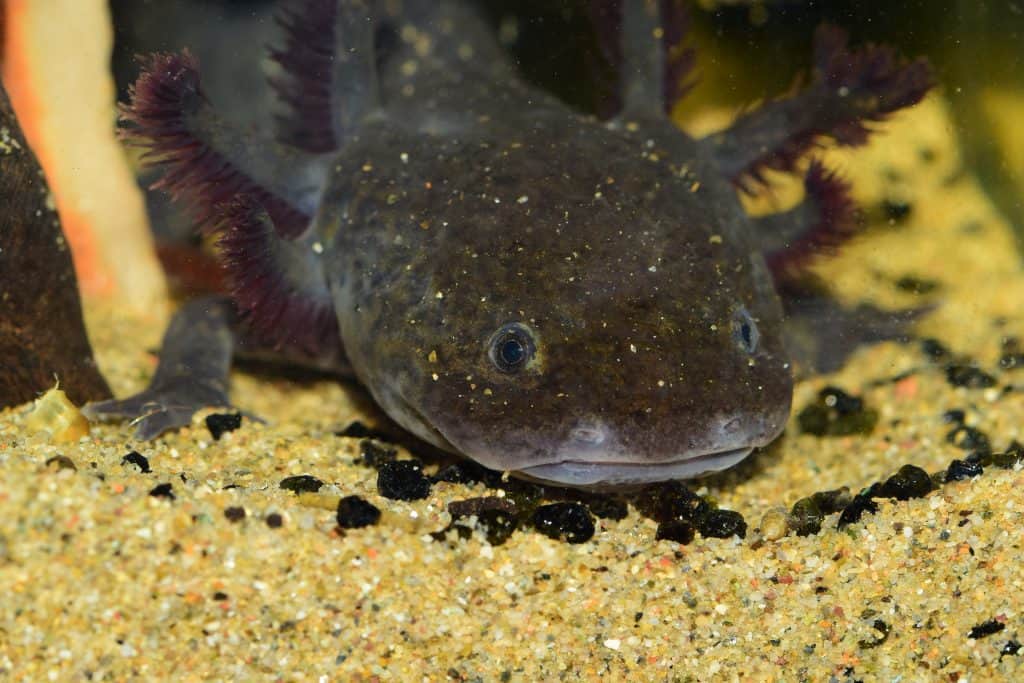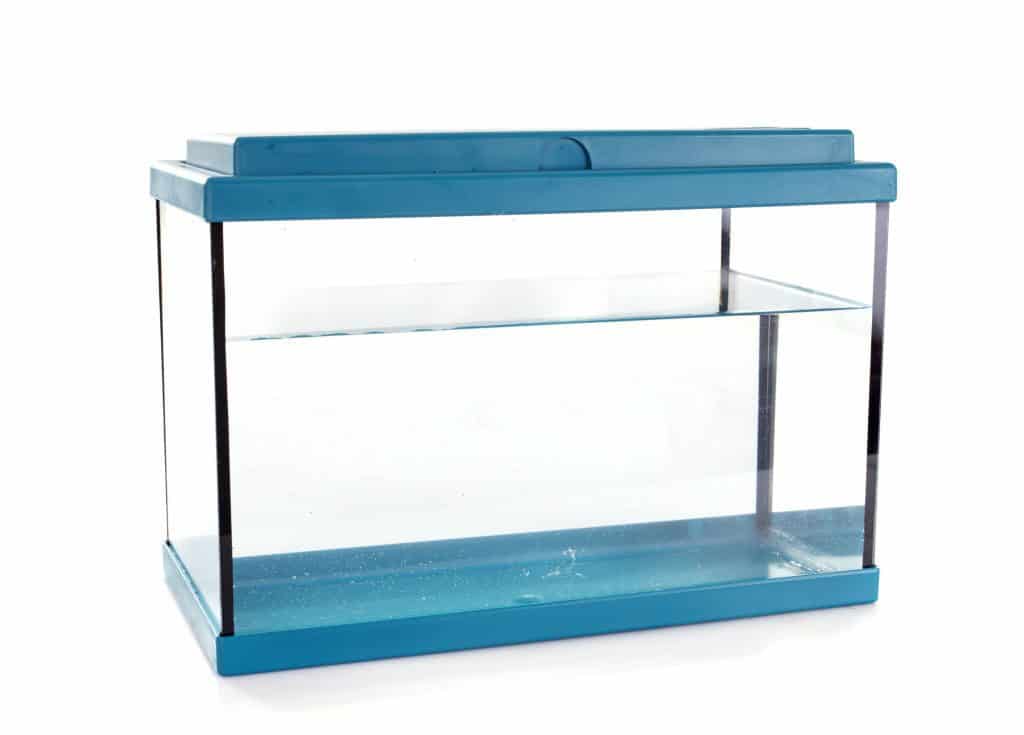Blue Axolotl: A Beginner’s Guide With Pics, Cost to Buy, and Care Info

If you have ever seen a picture on the internet of an Axolotl, you’ve probably thought they looked a little weird and wanted to know a little more about them. A common myth is that there are Axolotls that come in shades of blue, but this isn’t quite true.
Contrary to what some pictures may show, there really is no such thing as a truly blue Axolotl. The Axolotl that appears blue is actually a very dark gray. These are usually referred to as Melanoid Axolotls, which are one of many color variations in the Axolotl species and is actually almost black in color.
If you are completely new to Melanoid Axolotls, care for this creature is similar to that of a Pink Axolotl. As such, I have laid out the history of this creature along with some general tips for you to be successful in raising your own Axolotl.
Axolotl History
Axolotls are basically just Aquatic Salamanders native to Mexico but are close to extinction in the wild due to pollution. Axolotls are amphibians that were once named after an Aztec God who was said to have hidden by disguising his body as a salamander. These creatures are also referred to with names such as “Walking Fish” since they retain most of their larval features as they continue to grow.
Lake Xochimilco, in Mexico, is one of the Axolotl’s few natural habitats. However, according to National Geographic, in recent years, the number of Axolotl numbers in the wild has dropped from 6,000 to 35 Axolotls in a square kilometer.
With this dramatic drop in numbers, it is being debated that with the release of non-native species such as the Tilapia and Mojarra into common waters.
This decrease has also seemed to be caused by the dramatic chemical release coming from Mexico’s cities as they take the freshwater for the cities and release the waste back into the original waters.
With the help of conservationists and biologists alike, Axolotls are slowly being reintroduced into the wild on a daily basis. These animals thrive under the care of a lab, producing about 1500 eggs in each
What is Different About the Melanoid Axolotl?
These Axolotls tend to appear as one solid color and do not seem to have flecks of other colors throughout their bodies. They may often appear to be black in dark lighting.
These Axolotls will also try to blend into their surroundings, so depending on their tank, you may notice your Melanoid’s color either darkening or lightening.
However, no matter what color your Melanoid may be at certain stages of its young life. as it ages, your Melanoid will always end up being more black in color.
In some cases, you may actually have a heavily marked Melanoid. In these particular cases, these Axolotls can actually appear to be a much lighter blue in color and appearance.
Axolotls such as these could have had two completely black Melanoid parents and still come out with bright gold flecks on their skin.
With this specific variation, the Melanoid could possibly be what others are calling a “Blue” Axolotl. But in all reality, a Melanoid’s color is much closer to black than it could ever be to blue.
When it comes down to it, no Blue Axolotl really exists on the Earth today, and never has.
Where to Buy an Axolotl
Axolotls are actually considered to be an exotic pet in the United States. So if you live in America, the first thing you’ll need to find out is whether or not Axolotls are legal where you live. Below is a list of states where owning an Axolotl is illegal…
- California
- Maine
- New Jersey
- New Mexico
- Virginia
For the most part, Axolotls really aren’t that hard to find. I have found that if you are very serious about buying one of these pets, you can easily find them for sale online. There are even Facebook groups that you can join that are solely for networking with Axolotl owners and buying your own. They provide a venue for you to reach out to local breeders and enthusiasts.
Axolotls can also be found at just about any exotic pet store. Axolotls range in price as well. For younger Axolotls, the price is about $20 while adults can cost up to $35. These are one type of animal that actually gets more expensive as they age!
How Do I Set Up My Axolotl Tank?
Axolotls are actually very similar to many types of freshwater fish when it comes to setting up their tanks. They thrive much better in a tank that has good filtration. You can find water filters such as the Marineland Magniflow Canister online or in stores such as PetSmart and PetCo.
Axolotls are also very messy animals, so good filtration is key. Along with a good filter, your Axolotl will also rely on you to do weekly water changes for them. One way you can do this is buying a turkey baster, and basting the water.
Because of their nature, a tank with length is better for Axolotls than a tank that has depth. This is because these animals prefer to float at the top of the tank or to be roaming around on the floor of the tank. So, if you are beginning to buy things for your Axolotl, you should buy a tank at a minimum size of 2 ft.

When filling up your Axolotl’s tank you should try to keep the water temperature at about 68 degrees at the warmest. These animals are used to living in mountainous areas where the water is much colder. Also, be sure to keep your water at a pH range of 6 1/2 to about 8.
When decorating your tank, it is completely up to you in regards
Along with decorating, it is still up for debate concerning whether or not including small stones at the bottom of the tank is a good idea. Some people prefer to keep their tank bottom bare in order to prevent their Axolotls from swallowing stones. But others claim that Axolotls actually swallow these stones to help them to stay buoyant
Lastly, it is important for you to remember that Axolotls are sensitive to bright lights (although they will glow when exposed to blue or green light). So, it is imperative that you keep the level of light in your tank low.
What Can My Axolotl Eat?
Axolotls are a very strange animal but they require a pretty minimal diet. For younger Axolotls, you should be feeding them once every day. Older Axolotls should be fed about once every two or three days. A good rule of thumb is to keep your Axolotls abdomen about as wide as their heads.
For Young Axolotls:
- Frozen Bloodworms
- Small Micro-worms
- Live Black-worms
For Adult Axolotls:
- Red Wigglers
- Night Crawlers
- Soft Sinking Salmon Pellets
You should be able to find just about all of these foods at your local Walmart or any bait and tackle shops.
Keep in mind that when feeding your Axolotl, Variety is key! Just imagine what it would be like if you had to keep eating the same thing every day.
Finally, Axolotls do much better in species only tanks, since they like to eat fish, and fish may sometimes try to bite at your Axolotl’s gills. Unless you are raising feeder animals that will one day be food for your Axolotl, it is best to keep them separate from other species.
It is also important for you to know that while Axolotls do better in tanks with other Axolotls, Axolotls of smaller sizes of about 6 inches and under start to become cannibalistic.
Ease of Care
Because Axolotls are not a very common pet, it is sometimes more difficult for their owners to learn just how to take care of them. Axolotls should usually be cared for by those who already have some experience caring for fish, reptiles, or amphibians.
These creatures are not ideal for first-time fish owners because they require quite a bit of upkeep and care.
Related Questions
Do Axolotls come in different colors? Axolotls come in many shades in hues. The most common variety is called the Leucistic, or Pink Axolotl. But there is also the Wild type Axolotl and even the Gold Axolotl.
Are Axolotls prone to illness? Axolotls are mostly prone to fungus in their gills. If this is the case, you may notice your Axolotl shaking their head a lot. Pay attention when your Axolotl is doing this, and check to see if anything is coming off of their gills. This could be a symptom of another disease but is most likely being caused by stress.
